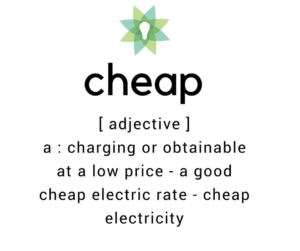Last Updated on November 5, 2024 by Kelli
Commercial Electricity Plans for Restaurants
Texas has a deregulated energy market where businesses can choose their retail electricity provider (REP). In the case of restaurants and other commercial buildings, there are two possible scenarios:
- If you have less than five power meters and your monthly bill does not exceed $2,500, you can choose your commercial energy plan online.
- If you have five or more power meters or your consumption exceeds $2,500, you can request custom quotes from retail electricity providers.
As you can see in the table above, the typical restaurant in Texas has a monthly power bill below $2,500. In this case, you can choose a business electricity plan online, with no need to contact providers for custom offers. At the Texas average rate of 9.22 cents per kWh, a monthly bill of $2,500 is equivalent to an average consumption of around 27,100 kWh.
- In Texas, commercial electricity rates are typically much lower than residential rates.
- As of October 2024, commercial rates in the Dallas-Fort Worth metroplex range from around 8.5 to 13.1 cents per kWh.
- Business electricity rates in Houston range from around 10.2 to 12.5 cents per kWh.
Your restaurant’s monthly electricity bill can vary widely depending on your rate. A monthly consumption of 20,000 kWh represents $2,600 at 13 cents per kWh but only $1,800 at 9 cents per kWh. Before choosing an electricity plan, make sure you read its contract terms and conditions carefully — some restaurant electricity plans may have hidden fees that drive up your monthly bills.
Start by Entering Your Zip Code:
Average Utility Cost per Square Foot of Restaurant Space
Using energy usuage data and electricity price figures from the US EIA, the average electricity cost per square foot of restaurant space can be estimated.
| Building Type | Annual Consumption per Square Foot | Electricity Cost at Nationwide Rates | Electricity Cost at Texas Rates |
| Food service
(in general) |
43.8 kWh/sq.ft. | $5.95/sq.ft. | $4.04/sq.ft. |
| Fast food | 62.8 kWh/sq.ft. | $8.53/sq.ft. | $5.79/sq.ft. |
| Restaurant or cafeteria | 40.6 kWh/sq.ft. | $5.51/sq.ft. | $3.74/sq.ft. |
| Other food service | 29.0 kWh/sq.ft. | $3.94/sq.ft. | $2.67/sq.ft. |
Restaurant power consumption per square foot can vary widely, among other factors, depending on your chosen electricity plan and the energy efficiency of your electrical equipment.
Restaurants and Energy Consumption
Restaurants and other food service buildings consume much more electricity per square foot than the typical commercial building in the US.
- According to the Commercial Building Energy Consumption Survey (CBECS) from the US Energy Information Administration (EIA), the average electricity consumption in commercial buildings is 12.6 kilowatt-hours (kWh) per square foot per year.
- This figure increases to 43.8 kWh per square foot in food service buildings, 248% higher than the average consumption of all commercial buildings.
The CBECS also provides an electricity consumption breakdown for specific types of food service buildings:
| Building Type | Number of Buildings Surveyed* | Average Floorspace per Building* | Average Consumption per Building* | Average Consumption per Square Foot |
| Food service
(in general) |
286,000 | 4,800 sq.ft. | 212,000 kWh/year | 43.8 kWh/sq.ft. |
| Fast food | 70,000 | 4,100 sq.ft. | 260,000 kWh/year | 62.8 kWh/sq.ft. |
| Restaurant or cafeteria | 175,000 | 5,300 sq.ft. | 214,000 kWh/year | 40.6 kWh/sq.ft. |
| Other food service | 41,000 | 4,100 sq.ft. | 120,000 kWh/year | 29.0 kWh/sq.ft. |
| All commercial buildings | 5,613,000 | 16,900 sq.ft. | 213,000 kWh/year | 12.6 kWh/sq.ft |
*Note: US EIA published values are rounded to the thousands.
At 62.8 kWh per sq.ft., fast-food restaurants have the highest energy consumption intensity among food service buildings. This figure is 398% higher than the average consumption of commercial buildings in the US.
How Much is the Average Electric Bill for a Restaurant?
Here we estimate the typical electricity bills for a restaurant owner, based on the consumption figures from the table above. We also use the latest electricity price data from the US EIA.
Typical Electricity Bills in Restaurants at Nationwide Commercial Electricity Rates
The table below is based on the US average commercial rate of 13.58 cents/kWh, reported by the EIA as of October 2024:
| Building Type | Average Annual Consumption | Average Monthly Consumption | Average Annual Power Bill | Average Monthly Power Bill |
| Food service
(in general) |
212,000 kWh | 17,667 kWh | $28,790 | $2,399 |
| Fast food | 260,000 kWh | 21,667 kWh | $35,308 | $2,942 |
| Restaurant or cafeteria | 214,000 kWh | 17,833 kWh | $29,061 | $2,422 |
| Other food service | 120,000 kWh | 10,000 kWh | $16,296 | $1,358 |
Typical Electricity Bills in Restaurants at Texas Commercial Electricity Rates
The table below shows typical power bills in restaurants, specifically for Texas, based on the EIA average rate of 9.22 cents/kWh, which is 32% lower than the national average.
| Building Type | Average Annual Consumption | Average Monthly Consumption | Average Annual Power Bill | Average Monthly Power Bill |
| Food service
(in general) |
212,000 kWh | 17,667 kWh | $19,546 | $1,629 |
| Fast food | 260,000 kWh | 21,667 kWh | $23,972 | $1,998 |
| Restaurant or cafeteria | 214,000 kWh | 17,833 kWh | $19,731 | $1,644 |
| Other food service | 120,000 kWh | 10,000 kWh | $11,064 | $922 |
Energy Incentive Programs for Restaurants
Electric utility companies in Texas offer incentive programs for many types of residential and commercial buildings, including restaurants. Here are the top energy incentive programs for the restaurant sector in Texas.
| Program Name | Location | Description |
| Oncor Food Service and Hospitality Incentive Program | Dallas-Fort Worth and surrounding areas | Oncor offers incentives for ENERGY STAR commercial cooking equipment, refrigeration upgrades and repairs, heating and cooling system upgrades, LED lighting and other energy efficiency measures for restaurants.
The program has predetermined incentive rates for each type of measure. The minimum incentive is $500, while the maximum incentive is 50% of total project costs. |
| CenterPoint Energy Commercial High-Efficiency Foodservice (CHEF) Program | Greater Houston metropolitan area, excluding areas served by other utility companies | CenterPoint offers incentives for energy-efficient food service equipment. The list includes commercial dishwashers, icemakers, combination ovens, convection ovens, fryers, steam cookers, griddles, and food-holding cabinets.
The incentive amount is calculated per piece of equipment, ranging from $30 to $1,900 depending on the specific equipment type. CenterPoint Energy also offers energy incentives for commercial buildings in general, covering measures such as LED lighting and air conditioning upgrades. |
| Austin Energy Commercial Kitchen Equipment Rebates | Austin | Austin Energy offers incentives for ENERGY STAR-certified kitchen equipment, including: combination ovens, commercial dishwashers, food holding cabinets, electric fryers, spray valves and electric steam cookers.
The incentive amount depends on the type of kitchen equipment, ranging from $75 to $2,310 per piece of equipment. Austin Energy also offers incentives for commercial building upgrades in general, including LED retrofits and HVAC upgrades. |
| CPS Energy Small Business Program | San Antonio | CPS Energy offers incentives for a wide range of energy efficiency measures that can be implemented in small businesses, including restaurants.
Like many similar programs, the incentive rates are determined by the types of energy upgrades. CPS also offers air conditioner tune-ups and instant discounts for energy-efficient light bulbs. The CPS Commercial & Industrial Program offers similar incentives but focuses on larger businesses. |
Solar Power Systems for Restaurants
Compared with many other types of commercial buildings, restaurants have an above-average electricity consumption per square foot. If your restaurant has its own parking area or roof, you can save on electricity bills with solar panels.
According to the Solar Energy Industries Association (SEIA), commercial-scale solar systems have an average cost of $1.44 per watt — or $1,440 per kilowatt. The average US restaurant has an energy consumption of 214,000 kWh per year, which can be generated with a solar system capacity of around 150 kilowatts.
- A 150-kW solar system typically costs $216,000, but this figure decreases to $151,200 with the 30% solar federal tax credit.
- At 10 cents per kWh, an annual consumption of 214,000 kWh is equivalent to $21,400.
Based on these figures, a solar panel system can achieve a payback period of around 7 years in a restaurant. However, high-quality solar panels have a guaranteed lifespan of 25 years or more.
If you prefer to avoid the upfront cost of installing solar panels in a restaurant, you can finance them with a low-interest loan. There are also companies that offer solar leases for restaurants: you pay a monthly fee to use a photovoltaic system that is owned and operated by the provider.
What Are Demand Charges in Texas Small Business Electricity Plans?
One of the most important differences between residential and commercial electricity plans is the presence of demand charges. Residential consumers are only billed for the total amount of energy used, but many businesses are also billed for the demand caused by the grid.
Here is a simplified example that explains the concept:
- Assume two companies both use 100,000 kWh per month.
- However, one company reaches power consumption peaks of 500 kW, while the other company only reaches 250 kW.
- Both companies use the same amount of electricity, but the first company places twice as much demand on the grid.
For this reason, the company with a 500 kW consumption peak can expect higher demand charges.
In Texas, demand charges for businesses are calculated each year based on the concept of Four Coincident Peaks (4CP). ERCOT identifies the four hours when the grid experiences the highest demand during each of the four summer months: June, July, August, and September. The demand charges paid by your company will be determined by your measured demand during those four hourly intervals of high consumption (4CP).
Nobody knows when the Four Coincident Peaks will happen each summer, but ERCOT publishes alerts when a potential 4CP event is detected. If your company can reduce its kilowatt demand during these critical hours, you may achieve a drastic reduction of demand charges for an entire year (until next summer when ERCOT measures a new set of 4CP hours).
Demand Charges in Business Power Bills: A Quick Example
The TDU tariff category can have a major impact on business power bills. Here is a simplified example that demonstrates how this works:
- Assume two small businesses are consuming 3,500 kWh per month with an energy charge of 9 cents/kWh, in the Oncor service territory.
- However, Company #1 has a peak demand of 8 kW while Company #2 reaches 16 kW.
In this case, both companies get the same energy charge of $315 ($0.09 x 3,500 kWh), but their TDU charges are very different.
Company #1 has a peak demand of 8 kW, which means there is a fixed fee of $6.87 and a variable fee of 3.7984 cents/kWh. The total TDU charge is $139.81, and the total amount billed after adding the energy charge is $454.81.
Company #2 has a peak demand of 16 kW, which means there is a fixed fee of $32.43 and two variable fees: 0.0642 cents/kWh and $10.332973/kW. The total TDU charge is $200.00, and the total amount billed is $515.00.
Note how the power bill increases by over $60 due to TDU charges for Company #2, even when both have the same consumption and energy price. Residential consumers only need to watch their kWh usage, but peak demand is also important for businesses.






